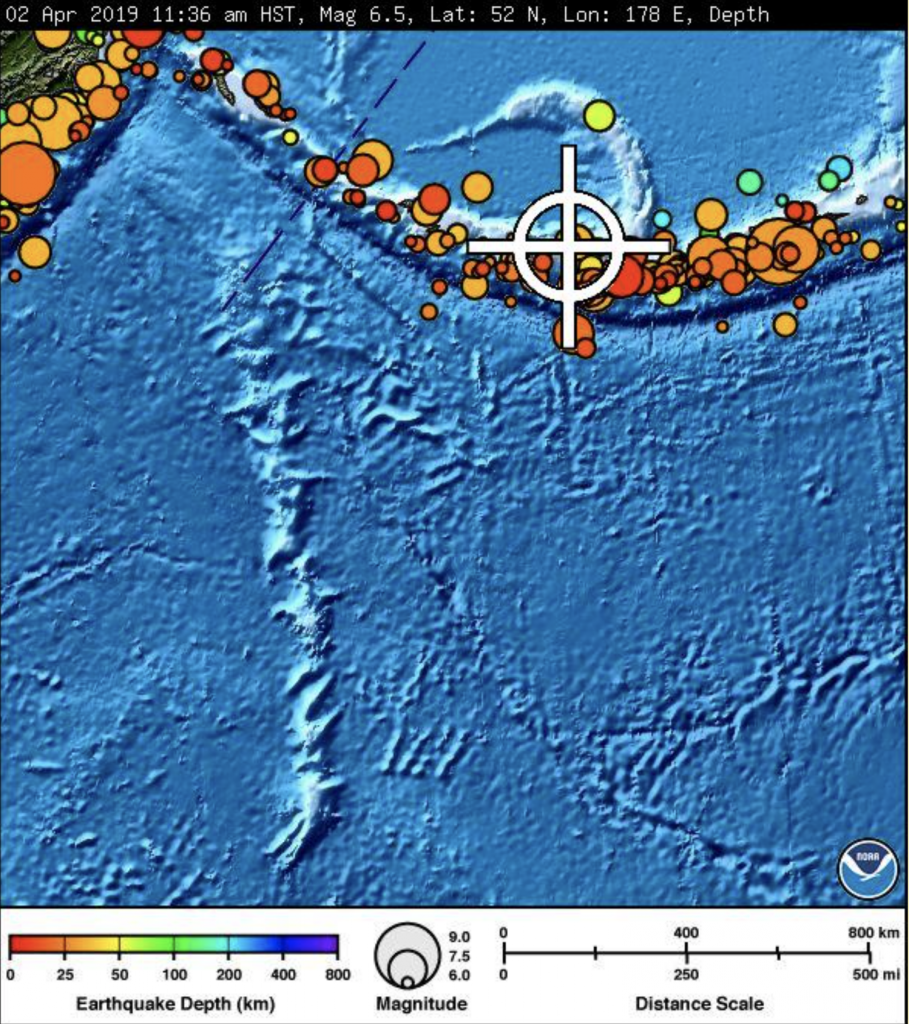No Tsunami Threat From Alaska Earthquake
AN EARTHQUAKE HAS OCCURRED WITH THESE PRELIMINARY PARAMETERS:
ORIGIN TIME – 1136 AM HST 02 APR 2019
COORDINATES – 52.0 NORTH 178.0 EAST
LOCATION – RAT ISLANDS ALEUTIAN ISLANDS ALASKA
MAGNITUDE – 6.5 MOMENT
BASED ON ALL AVAILABLE DATA A DESTRUCTIVE PACIFIC-WIDE TSUNAMI IS NOT EXPECTED AND THERE IS NO TSUNAMI THREAT TO HAWAI‘I.
Hawai‘i Emergency Management Agency (HI-EMA) encourages the public to take tsunami preparedness into their own hands this April during Tsunami Awareness Month.
Over 70 years ago, on April 1, 1946, one of the deadliest tsunamis to ever hit Hawai‘i caused widespread devastation on all islands. Generated by an earthquake in the Aleutian Islands, the massive tsunami took 159 lives and caused more than $26 million in damage. April was chosen as Tsunami Awareness Month to honor and remember the lives lost in all tsunamis that hit the state.
Due to Hawai‘i’s location in the middle of the Pacific Ocean, we are extremely vulnerable to the threat of tsunamis. Distantly generated tsunamis can reach Hawai‘i within several hours and are triggered by earthquakes that take place along the Ring of Fire, which circles the Pacific Rim.
Locally generated tsunamis are caused by earthquakes or volcanic activity that occur in or near the Hawaiian Islands and can make landfall in a matter of minutes.
“We cannot stress how important it is that residents be prepared for a possible tsunami that can strike at any time,” said Tom Travis, administrator of Emergency Management. “Being aware of potential hazards and knowing how to be notified of an impending catastrophe is key to surviving a disaster. Just as imperative are emergency preparedness kits to be used in the aftermath period as well as the information on knowing how to evacuate and find shelter during a catastrophic event. A tsunami cannot be outrun.”
For distantly generated tsunamis, outdoor warning sirens will sound statewide. For locally generated tsunamis, however, there may not be enough time to sound sirens. If you are near the ocean when an earthquake takes place, immediately move to higher ground. Upon hearing any warning sirens, the public should tune immediately to a radio or television for updates and the latest information. Additionally, everyone should be able to recognize the natural warning signs that a tsunami may be imminent. Signs include: rapidly rising or receding water from the ocean, the sound of a locomotive or jet plane coming from the ocean, and empty beaches.
People located within a tsunami evacuation zone should quickly move to higher ground, or inland until they are at least 100 feet above sea level, while avoiding steep cliffs and watching for falling rocks. To find out if you live, work or play within a tsunami evacuation zone, enter your address into the Tsunami Evacuation Zone Map Viewer on HI-EMA’s website or turn to the disaster preparedness pages in your local telephone book.
On Saturday, April 6, the Pacific Tsunami Museum (PTM) in Hilo will host a Keiki Day Open House event with free admission to the public. During the event, guests can learn how to best prepare for tsunamis.
The following Saturday, April 13, PTM has invited tsunami subject matter experts. Guests can speak with scientists, natural hazard planners, and others.
On Saturday, April 20, PTM will host “Survivor Stories from April 1, 1946.” PTM is a nonprofit organization dedicated to promoting tsunami awareness and education through a combination of science, history and personal accounts.
For more information about the open house, call (808) 935-0926.















